Borneo is an amazing adventure destination and one not to miss if you love the outdoors and activities such as hiking and snorkeling. That’s not to say there aren’t things to do for the traveler who likes to take it easy – there’s beautiful beaches to laze about on and luxury hotels that aren’t too expensive to enjoy.
Borneo is one of the more expensive places to visit in South East Asia. But that’s not to say a holiday there still can’t be done on a budget. You can certainly do most things even by spending just US$40 a day, especially if you map out your adventures before you get there.
When to visit Borneo
Borneo is in the tropics so you can expect it to be hot and humid year round. In fact, the average humidity is a steady 80%, so be prepared to get your sweat on. In some areas though, Borneo is quite mountainous and the higher altitudes provide some cool relief.
Down at sea level, you can expect the temperatures to range between 80F – 90F (27 and 32°C) all year long. Rainfall varies throughout the different months and can be sporadic. It generally rains the most between November and March, but even during these months it can be unpredictable – you can visit Borneo during this time and still have a string of bright and sunny days.
Many people come to Borneo to experience the unique wildlife and some of the best times for this are between June and August. This is when it’s the fruiting season, meaning many of the primates, namely orangutans, come down for the tops of the trees to feast on the fruit.
Places to visit in Borneo
Borneo is located in the rugged north of Malaysia and you could really spend a good month travelling around Borneo. However, if you are a bit short on time then I’ve outlined the best parts and must see places to go to.
Kuching
Kuching is one of the main cities in Borneo and a good starting point for your trip. It is a modern city and there’s a lively nightlife with a beautiful riverside walk that is spectacular at sunset.
The museums in the town and activities nearby, such as the Sarawak Cultural Village and the orangutan center, should keep you occupied for a few days at least. Bako National Park is also a brilliant place to spot wildlife and is only about an hour from Kuching.
Sandakan
Located in the north-east of Borneo, in the state of Sabah, Sandakan is a historical place that holds a lot of significance for World War II.
Learn about the region’s brutal history by visiting the site of Japanese prisoner of war camps, housed in a beautiful forest. The Sandakan Memorial Park is the site of ‘death marches’ in which more than 2,000 prisoners died walking from Sandakan to Ranau. Just six Australians survived their horrific imprisonment in the area: and only because they escaped.
Another historical place to visit is the Japanese cemetery where many prostitutes from the war are buried. A prominent madam founded by the cemetery, which also hosts a monument dedicated to fallen Japanese soldiers.
Sandakan is a good jumping off point for exploring the rest of the Sabah region. From here, you can travel about four hours to reach the Kinabatangan River. This is a great place to see amazing amounts of wildlife in Borneo.
Kota Kinabalu
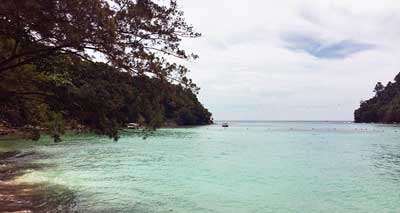
Kota Kinabalu is also a couple of hours from Mt Kinabalu, which is a beautiful place to hike. Even if you’re not up for climbing the mountain itself, the National Park (which is UNESCO listed) features dozens of hiking trails that make for great day hikes.
Getting around Borneo
Borneo is relatively inexpensive to travel around in. Whether hiring a car, catching a bus, or getting on the plane, you can normally find reasonably priced fares.
Public transport
Most of the National Parks in Borneo – even the ones located a couple of hours from the city – are frequented by public buses. Though these are the cheapest options for getting around, be prepared to be patient, as they don’t all run on a schedule. In fact, some of the buses only leave once they are full, meaning you could be waiting for an hour or more.
Most of the time, these buses will be the most frequent at the beginning of the mornings and then towards the end of the afternoons, as this is when most people travel to and from their destinations. If you’re flexible, public transport is certainly the way to go, as a two-hour trip can cost you as little as US$5.
Hiring a car
Car hire is very affordable in Borneo and you can expect to pay as little as US$30 a day for a basic model, including insurance. Most companies will ask for a deposit, which is normally done as a hold on your credit card, but this usually won’t be more than US$200.
The roads in Borneo are well looked after and easy to drive. There also isn’t much congestion, especially away from the larger cities. In rural areas, the rain can sometimes wreak havoc a little, causing flooding and landslides, but if you’re not travelling during a rainy period you shouldn’t have to worry.
It is generally easier to rent a car from the cities you are visiting, and then fly in between the cities. You sometimes need to prove you own the car if you cross in between the states of Borneo, and this can cause a headache. It will also cost you quite a bit more if you pick up the car from one city and drop it off in another.
It can be handy to have an international driver’s license, however we just showed our own country’s license for one rental, and for another rental they didn’t request to see a driver’s license at all!
Flights within Borneo
Most major flights in to Borneo come through the Kuala Lumpur hub of Malaysia. Because Air Asia is a Malaysian airline, it services a lot of the Borneo region and you can get really great deals if you book in advance. In fact, some tickets sell for as little as US$30 a flight, making it the cheapest and easiest option for travelling long distance.
Accommodation in Borneo
The accommodation in Borneo is varied and you’re bound to find something to suit your budget. If you have the time to do your research, you can find very nice digs for as little as US$20 a night. Unlike its neighbor Brunei, there are budget options in Borneo.
Longhouses
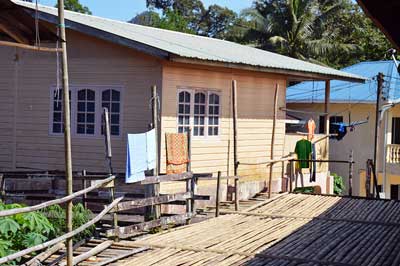
Go out to the countryside and indeed deep into the jungles of Borneo, and you will find many locals still living in this traditional housing.
Over the years, longhouses have become more popular with tourists, as they opt to find somewhere authentic to stay.
Longhouse accommodation can range vastly from air-conditioned rooms with regular queen sized beds, to long rooms with mats on the floor and people sleeping side-by-side. Of course, the price will be reflected accordingly.
In general, the longhouses closer to the cities are more modern, featuring TVs and electricity, and the experience may be less authentic, if more comfortable. The more authentic experiences can give you a unique insight into the traditional way of life and you could even have the opportunity to learn hunting techniques, like shooting a blow gun, and get a class in traditional dancing.
Longhouse stays are best arranged in advance, through agencies like the Sarawak Tourism Board, as normally the stays are organized through a registered guide.
Luxury hotels for less
When we were in Borneo, this is the accommodation we opted for. Significantly cheaper than hotel stays in the west, you can stay in comfortable, four-star accommodation for as little as US$60 a night. For US$80 a night we had a huge apartment with two bedrooms, a lounge area and kitchen, in a good part of Kota Kinabalu town.
We stayed at Citadines Uplands Kuching in Kuching and Borneo Vista Suites Hotel in Kota Kinabalu. Services like booking.com are a great way to find these kinds of deals.
Hostels
In the larger cities, such as Kota Kinabalu and Kuching, there is certainly hostel accommodation to be found, although not in the quantities you’ll get in other South-East Asian countries. Still, budget accommodation is certainly available.
In Kota Kinabalu, some of the highly recommended hostel include Masada Backpackers and H2 Backpackers.
In Kuching, check out Lodge 121 and DIY Dorm.
You can expect to pay about US$7 a night for a dorm room, and US$18 a night for a private room with air conditioning.
Bed and breakfasts, homestays and guesthouses
A bit more expensive than hostels but coming with more privacy, homestays are another good option if you’re on a budget. In some places, homestay owners will come to bus stations to meet tourists off the bus, encouraging them to come and stay at their homestay. If this happens to you, use the opportunity as a chance to bargain. However, if the thought of this frightens you, it is easy enough to book a homestay online in advance.
Most of the homestays are small operations run by families, including breakfast in the price or for a small fee. It’s another way to get an insight into local life, although a more modern local life compared to those living in longhouses.
Guesthouse prices vary widely, from US$7 a person to US$50 a night.
Food in Borneo
Food in Borneo is distinctly Malaysian although it is easy to find budget eats from many different regions in Asia.
Our favorite places to eat were inside the hawker’s markets and food courts. It’s very simple to find delicious budget food in these locations.
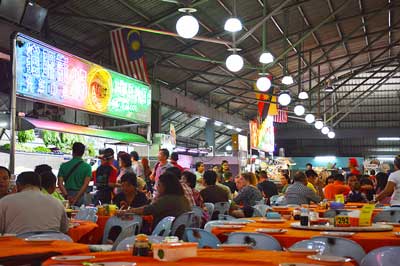
In Kota Kinabalu, the Filipino night market has some seriously cheap eats, ranging from more seafood, to rice and noodle dishes, to chicken skewers. There are also a range of traditional desserts and cakes to be found. You can feel full after paying just US$5 per person here and eating a range of foods. Don’t be afraid to bargain on the seafood if the prices aren’t clearly marked.
In all the major shopping centers (and there are plenty around the cities of Borneo) you can find food courts. These food courts are really worth visiting, as you can often sample an array of Malaysian and Asian food in the one space. Borneo food tends to be a mix of Malay, Chinese and Indian, and you can find a great combination of these flavors inside these food courts.
Because of the influences on the cuisine, you shouldn’t have to look far to find a delicious curry or tasty dim sum in Borneo.
Adventure and cultural activities in Borneo
If you’re after adventure and cultural activities, then Borneo really is a must visit South-East Asian destination. Although a relatively small region, its beautiful beaches, high mountains and lush jungle make for a diverse eco landscape that begs to be explored.
The native people also have a fascinating culture and many of them still live in villages, practicing their traditional customs and traditions just like they were decades ago.
Cultural activities
Sarawak Cultural Village
The Sarawak Cultural Village is located about an hour’s drive from Kuching, and there is a shuttle bus leaving to and from the Grand Margherita Hotel in the center of the city to take you there. The bus costs about US$3 one-way.
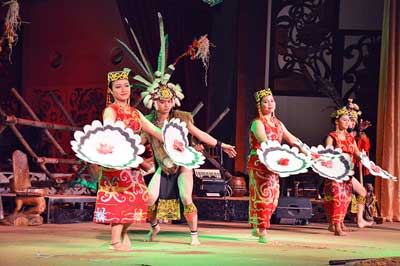
Make sure you catch one of the two shows, which are on at 11.30am and 4pm daily. The 45-minute performance features blow gun practice, dancing and a variety of music from the different regions.
Entrance to the village costs about US$17, which is certainly on the pricier end as far as cultural experiences go, but we felt it was worth it.
Mari Mari Cultural Village
The Mari Mari Cultural Village is the Kota Kinabalu equivalent cultural experience, and is also located about an hour outside of the city.
The difference between this cultural center and the Sarawak one is that you get a guided tour around the village, meaning you can learn more about the cultures.
During the two-hour tour, you will learn about the housing, history, traditional dancing and hunting of the tribes.
It’s a little more expensive to visit – about US$22 per person – although it does include lunch or dinner depending on what time of day you book your tour. If you want to get a lift to and from your hotel, the company will pick you up and drop you back for about US$42 per person. In this scenario it might be cheaper and easier to hire a car and get yourself there.
North Borneo Railway steam train ride
This is certainly not a budget activity, but it does look like a fun experience harking back to Borneo’s colonial times.
The North Borneo Railway ride leaves from the train station in Kota Kinabalu and takes you through the lush countryside, where you can enjoy a Tiffin style breakfast and lunch on board.
At US$78 a ticket though, this activity certainly isn’t cheap.
Adventures with animals
Semenggoh Wildlife Centre
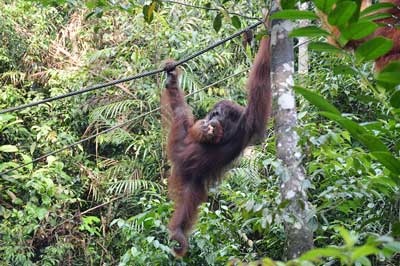
Proboscis monkey and firefly tour
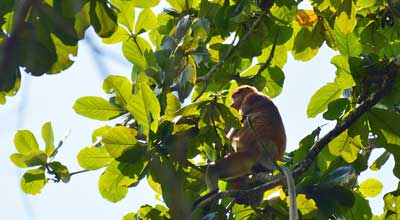
Tabin Wildlife Reserve
This reserve gives you the opportunity to walk along nature trails, see animals in the wild and do some dedicated bird watching. Located on the eastern side of the Sabah region, the reserve is a little off the beaten track but you can stay there if you want to make the trip worthwhile and un-rushed. Staying the night also enables you to go on night walks, giving you the chance to see nocturnal animals too.
Kinabatangan Wildlife Sanctuary
If we’d had more time, we certainly would have visited the Kinabatangan Wildlife Sanctuary. Located along the Kinabatangan River, there is a variety of accommodation in the area, many of which include tours out on boats to explore the local wildlife. You can see bears, leopards, orangutans, macaques, and many birds. In fact, it is probably one of the best regions in Borneo for wildlife spotting, and we’d recommend spending a few days here.
Adventure activities
Bako National Park
If the thought of a long tour in the hope of spotting a few proboscis monkeys turns you off, head to Bako National Park instead. Here we saw the monkeys up close and also saw other animals like wild boars and macaque monkeys. To get here it’s about a 45-minute drive from Kuching (although you can also get a public bus from the center of town) and then a 15-minute boat ride. It costs about US$10 per person for the return boat ride and then a further US$5 per person to enter the park. Our only regret is that we didn’t stay the night, as there were many trails to explore and we would’ve liked to spend more time hiking.
Island hopping around Kota Kinabalu
There are four islands off the coast of Kota Kinabalu that are easily accessible by a 15-minute boat ride. If you want a budget day out island hopping, simply head to the Jesselton Point Ferry Terminal where you can pay just US$10 to visit two of the islands, excluding a conservation fee of about US$2. You can also hire snorkeling gear for a steal. Many of the islands also have hiking trails, so if you get bored of lying on the beach you can get active too.
Mt Kinabalu National Park
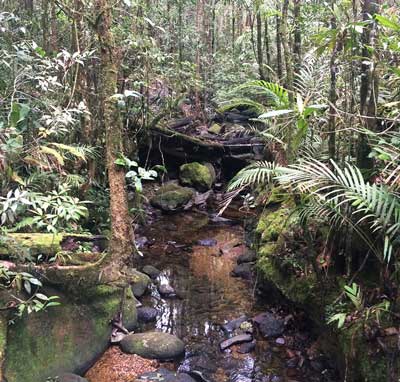
If the thought of hiking the whole mountain exhausts you, you can also hike the many trails within the national park. We hiked three over the space of the day when we visited, and they weren’t too tough. There is also lodging – although none of it is budget – within the park, if you’d like to stay a couple of days.
The park takes about two hours to get to from Kota Kinabalu, and there is a public bus that services the area from the town.
Danum Valley Conservation Area
Located in Sabah, Danum Valley is an ancient tropical forest and a place worth exploring. Naturalists will love its extensive trail systems and the chance to see animals in the wild, such as pygmy elephants, clouded leopards and sun bears.
Because of the diverse flora and fauna of the area, a lot of research is undertaken on the biodiversity of Danum Valley.
You won’t get bored in Borneo
If you like the outdoors and nature, there’s no way you will get bored exploring Borneo. There are so many adventure and cultural activities on offer that it’s easy to spend two weeks exploring the region and still feel as though you didn’t have time to see everything. True, it is a little more expensive than some other parts of South-East Asia, but we feel it’s a price that’s worth while paying.
Have you been to Borneo? What was your favorite part about the experience?
Carmen is one half of the couple behind Double-Barrelled Travel, a travel blog focused on vlogging. Carmen married Dave three years ago and they quit their journalism careers in mid-2013 for a life on the road.

Comment*We have a client wishing to do a 3 week tour around Borneo next July
Is this something you put together?
Steph,
We are just a travel information website and we don’t do bookings. Best of luck. -Roger
We visited the Dyaks in the 1970’s. Have a full slide show of our trip. We flew in a helicopter to Long Pahangi where we stayed with the Dyaks for a week then took Long Boats back down river. I have a complete slide show of our trip. I was a once in a lifetime adventure.
I’ve lived in Malaysia for more than 25 years and am married to a Sarawakian so know a little bit about Borneo. Roger Wade is right, buying locally is nearly always much cheaper than buying online, especially through international sites.
Overall this is a good read although it doesn’t communicate the sheer size of Borneo and how very different the Malaysia, Brunei and Indonesian parts of the – I hesitate to call it an island because it’s as big as France and England combined – island are.
It’s also a bit ambiguous when discussing driving, accommodation and food – long houses are found in Sarawak and roads maybe well looked after but driving outside of the main cities and towns can be stressful, especially in heavy rain while competing with over loaded logging trucks!
But overall it’s pretty accurate reporting. I’d also recommend the STB blog which seems to be getting more active and has some good insights into Kuching and other areas worth visiting. I recommend this article on the caves of Sarawak https://sarawaktourism.com/story/delving-into-sarawaks-magnificent-caves/ and also this one that provides insights into the beautiful beads of the local tribes and their history https://sarawaktourism.com/story/little-known-secrets-of-the-beads-of-borneo/
75USD for a 2-day Mt Kinabalu climb?! Where did you find such information? Which tour agency is it? I could find only tours which were 300-400USD… which is a total rip-off. So definitely would like to know which one was it!
Adrian,
This was an article by a freelance writer named Carmen and you’ll find her contact link at the bottom so that might be the best way of finding out more.
Personally, I (the editor) have not been to Borneo yet myself, but I might be able to explain what happened. Carmen was in Borneo for a couple weeks and researched and booked her activities once she got there. For Asia in particular, there can be an amazing difference between the price for things like tours that you see advertised on English-language websites and the price you pay if you book through a hostel when you are already there. For example, I spent 4 months in Vietnam a few years back and I would regularly book a full-day bus trip that included lunch and admission to an attraction and the cost was usually US$10 or less. People who were picked up from 4-star hotels might have paid US$20 for that same tour and would be sitting next to me. And if you booked the same day-trip online (say, on Viator) you’d probably be charged US$79 per person, with 25% of that going to Viator and most of the rest going to the people running the website where you found out about it.
Doing research before you get there is important, but in certain places you’ll find that booking tours and such online before you get there will end up costing a LOT more. But again, this is my own experience and Carmen might have done something different. She’s always been very reliable. -Roger